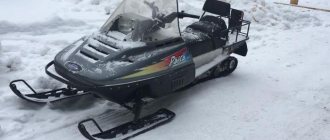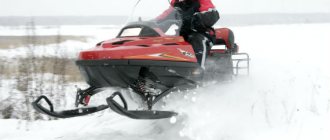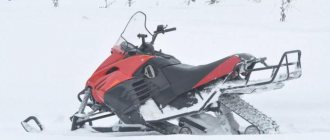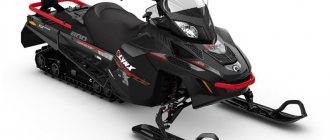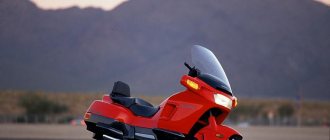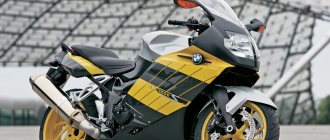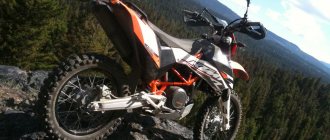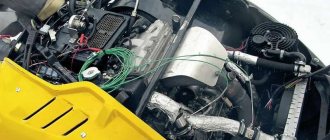Engine characteristics
| Engine model | Rotax® |
| Engine Configuration | Row |
| Number of cylinders | 2 |
| Engine cycle | 2 stroke |
| Cooling system | Liquid |
| Valve configuration | Reed Valve |
| Cylinder diameter (millimeters/inches) | 72 / 2.8 |
| Piston stroke (mm/inches) | 73 / 2.9 |
| Engine displacement (cubic centimeters/cubic inches) | 594.4 / 36.3 |
| Starter type | Electric/Pull |
| Fuel requirements | Premium |
| Fuel type | Gasoline / Injection |
| Turbocharging | — |
| Supercharger | — |
| Injector | + |
| Carburetor | — |
| Injection type | Direct injection |
| Emergency switch | Standard |
| Emergency Power Off (EPO) System | Standard |
Suspension
| Front suspension type | Telescopic |
| Front suspension travel (inches, millimeters) | 6 / 150 |
| Front stabilizer | — |
| Shock absorber type | Unregulated |
| Rear suspension travel (inches, millimeters) | 9.4 / 239 |
| Rear shock absorbers | 2 |
| Rear suspension model | SC-5 |
| Rear anti-roll bar | — |
| Front shock absorber model | Motion Control |
| Front shock absorber type | Hydraulic |
| Coilover | — |
| Rear shock absorber model | HPG |
| Rear shock absorber type | High pressure gas |
| Central shock absorber model | HPG |
| Type of central shock absorber | High pressure gas |
2013 Ski-Doo Tundra Xtreme Review
A good flatland snowmobile that has been tested in deep snow
Ski-Doo Tundra Xtreme is a unique, and for some, even bizarre snowmobile, combining a lot of components from different segments and manufacturers. Being a snowmobile from the snow, the machine, of course, bears the name Ski-Doo and Tundra. The chassis is REV and the seat and brakes are from the MXZ model. The 2-stroke direct injection engine is a collaboration between BRP, Rotax and Evinrude. And the front telescopic suspension and articulated rear suspension are borrowed from BRP's Swedish subsidiary Lynx.
Such a world
The snowmobile is in high demand in areas near or within the Arctic Circle, but for those who enjoy everyday riding on the nearby plains, the appeal of such a model is not entirely clear. Of course, we are not BRP marketing specialists with sales data in the server regions, where this model probably sells best. The snowmobile's footprint is truly enormous thanks to its 16-inch wide and 154-inch long track. Combine that with 2.25-inch-high track lugs, and you've got a sled that can tackle the toughest tundra terrain.
With the 600 E-TEC engine and large PowderMax track, you can confidently take on the unknown snow.
The target market for this snowmobile is regions with harsh conditions where snowmobiles are becoming increasingly popular, such as in Russia. A 2-stroke engine is excellent for working in Siberian frosts, where a 4-stroke engine may not warm up so easily. The E-TEC direct injection system ensures that the engine starts easily even in the coldest temperatures, resulting in a sled that is ideal for use.
The Ski-Doo Tundra Xtreme features Lynx Telescopic Strut (LTS) front suspension and narrow plastic Pilot DS skis.
Judging by sales data and marketing forecasts, you can make good money by producing models for such remote and frosty regions. Buyers there don't often see groomed snowmobile trails, but they aren't workers or hunters either. These are lovers of winter walks who need powerful and capable cars.
For this market, the Tundra Xtreme is just great, as are the so-called sport-utility models from Ski-Doo's competitors. There are quite a lot of non-standard and original models in the Ski-Doo lineup. Apparently, buyers from Scandinavian and other similar regions do not like to ride utilitarian snowmobiles, so Ski-Doo has expanded its range with the Expedition model, a crossover that combines the advantages of touring and utilitarian models. The Expedition shares much of the Ski-Doo Grand Touring trim, but the sled's platform is the utilitarian REV-XU. And the hero of this article, Tundra Xtreme, is also built on the XU base.
We've tested the Xtreme on the flats over the past few seasons, but Ski-Doo marketers keep harping on how good the sled is in deep snow. So we decided to look at the snowmobile from a different perspective and handed it over to the experts in the mountain segment of the snowmobile market. Having recovered from the shock of the news that they would have to go to the mountains on such a large and seemingly clumsy utilitarian snowmobile, they hit the road, after which they shared their impressions.
The miners' impressions
At first, we thought about the Ski-Doo Tundra Xtreme: “a truck with a track and two skis.” But the car has its own purpose and power.
The Tundra Xtreme is incredibly flexible in deep snow.
Without wasting any time, we went to explore the character of the sled: after all, it has a 154-inch track and an excellent E-Tec 600 HO engine
Thanks to its off-road ability, power and spaciousness, the Tundra Xtreme is a very good winter utility vehicle.
The two of us set off on the Tundra Xtreme: the driver in front, a person with a camera in the back. There is also another driver behind us on another mountain snowmobile.
We were immediately surprised by how easily the Tundra Xtreme handled carrying two passengers, even though it is not a two-person sled and is not designed for such use. The car did not slip or sag. After that, we decided to check how far the snowmobile could go and how deep the snow could handle it.
One thing we can say with certainty is that the Tundra Xtreme handles deep snow very well. It’s unlikely that we would compare it with the XM Summit, but this model is quite suitable for working in loose, deep snow.
The REV-XU chassis benefits from plenty of luggage space and a comfortable "X" seat.
The ergonomics of the Tundra Xtreme are excellent: the steering wheel is equally comfortable to operate both standing and sitting; The footrests and seat are spacious. The E-Tec 600 HO engine has no problem propelling the utilitarian REV-XU chassis. There's plenty of luggage space on the tunnel for tools, video equipment and more, and there's enough strap holes to strap anything on. The telescopic suspension with 32-inch ski clearance handles the sled's front end weight and load very well.
Again, we're not experts on two-seater or utility sleds, but we found the Tundra Xtreme to be a comfortable, useful, well-rounded, and very well-built utility model.
Bottom line
Tundra Xtreme is capable of covering many kilometers in any conditions, be it compact roads or deep snow.
As a result, once again hearing Ski-Doo praise the versatility of the Tundra Xtreme, we readily believe them. When mountain snowmobile experts say the Tundra Xtreme is deep-snow capable, we believe them. Among the many advantages of the snowmobile, I would like to note the relatively low declared weight (224.5 kg), the wide PowderMax track, narrow Pilot DS skis and the SC-5U articulated rear suspension, designed to work with a long track. 32 inches between skis and vertical aluminum handlebars with J-shaped handles allow the rider to maneuver through trees or climb slopes.
The snowmobile occupies a niche that, according to Ski-Doo marketers, was undeservedly empty. With its unique black finish with painted tunnel and hard side panels, the Tundra is sure to stand out in the snow and stand out from other models. Is a snowmobile right for you? Only you can answer this question, but tests on the flats and in deep snow show that the snowmobile is equally good in both.
2013 Ski-Doo Tundra Xtreme Features | |
| Engine | 2-stroke 2-cylinder Rotax E-TEC 600, liquid cooled, direct injection, 3-D RAVE |
| Power | About 120 l. With. (stated) |
| Drive unit | TRA III; QRS |
| Front suspension | Telescopic BRP LTS with Motion Control shocks; travel - 6 inches |
| Rear suspension | Sliding SC-5U with articulated rear; HPG shock absorbers; travel – 13.4 inches |
| Length | 131.6 inches |
| Width | 39.4 inches |
| Height | 51.0 inch |
| Distance between skis | 32.0 inches |
| Truck | 16 x 154 x 2.25 PowderMax |
| Weight | 224.5 kg. (stated) |
| Tank capacity | 40.1 l. |
| Equipment | Electric starter, Rotax Electronic push-button reverse, articulated rear suspension, telescopic front suspension, multi-function instrument panel, trunk, REV-XP "X" narrow seat, J-bar handlebars and mountain strap |
| Price | approximately $10,800 |
Specifications
| Footage) | 10.65 |
| Overall Width (inches/mm) | 39.4 / 1002 |
| Overall Height (inches/mm) | 50.3 / 1278 |
| Maximum ski base length (inches/millimeters) | 32 / 813 |
| Minimum ski base length (inches/millimeters) | 32 / 813 |
| Length (foot/foot) | 10 |
| Length (foot/inches) | 7.8 |
| Snowmobile Dry Weight (lbs/kg) | 495 / 225 |
| Fuel tank capacity (gallons/liters) | 10.6 / 40 |
| Engine displacement to weight | 1.2 |
Owner reviews
“The classic BRP Ski-Doo Tundra 600 is an inexpensive and playful car. I like that the snowmobile is suitable for recreation and work. At the same time, it consumes very little fuel. I previously rode Taiga. With poor parameters, the consumption was almost the same. I like everything about the BRP Ski-Doo Tundra 600: original design, cross-country ability, reliable suspension, good traction and high speed. The snowmobile is very durable and soft, regardless of the conditions, and so far it suits me (I’ve been riding it for 4 years).”
“I've been riding a Tundra 600 snowmobile for almost five years. Over the entire period I have completed many difficult trips across the tundra, and everywhere it was excellent. The size of the device is not the smallest, but thanks to its high-quality design and special methods of walking around while driving, it was possible to pass in different places. Protection of two elements: the bottom and the bumper helped to avoid damage. The elasticity and high efficiency of the power unit is a separate issue. In this regard, the car is almost incomparable to anything else. The model drives absolutely everywhere (perhaps it was also supported by the presence of a lower gear). I experienced negative emotions only in cold weather: the sound from the rollers, vibrations and crackling in the suspension annoyed me a little.”
“The BRP Ski-Doo Tundra 600 is a reliable machine. The average trip duration was 160 km. The build quality and parts of the snowmobile are good. Nothing rattles, nothing knocks. From the very beginning of using the technique, I noticed the only problem - oil was leaking slightly down the tank plug. I don’t even see any point in comparing it with Yamaha (the company doesn’t have the same models). The main competitor is Lynx Yeti, but from the same manufacturer. For the forest, the Ski-Doo Tundra WT 600 is the right option.”
“Tundra 600 ski doo ace is a hunter’s dream. In just over two years I drove about 3.5 thousand km on it. Of course there were breakdowns. After a thousand kilometers, the gearbox began to break down and knock. I had to take it to a repair shop. At the end of the second year of operation, it was necessary to replace the fuse for the fan unit along with the headlight. Otherwise, the Tundra 600 is a good device. It’s always easy to drive (well suited for trails, forests and loose snow). At the same time, efficiency and low noise levels are maintained regardless of the speed and conditions of use. BRP Ski-Doo Tundra 600 is better than many domestic models. The main negative quality is the high cost.”
Appearance
| Frame material | Aluminum |
| Housing panel material | Plastic |
| Frame model | REV-XU |
| FloorBoard Location | Driver |
| Slip resistance | + |
| Snowboard mount for tunnel | — |
| Handles | Standard |
| Saddlebag protection | — |
| Belt protection | + |
| Hand Guards | + |
| Shield protection | — |
| ExhaustGuard | — |
| LightGuard | — |
| Clutch protection | + |
| Snow protection | + |
| Side panel | — |
| Fuel Tank Cover | — |
| Shock Cover | — |
| Steering wheel | Standard |
| Steering pad | Standard |
| Front bumper | Standard |
| Rear bumper | Standard |
| Steering wheel hooks | Standard |
| Ski material | Plastic |
| Ski model | Pilot™ |
| Ski handles | Standard |
| Skag material | Carbide |
| Mountain steering wheel | Standard |
Snowmobile operating rules and safety precautions
The Tundra 600 can be operated by persons over 16 years of age and weighing less than 111 kg. Children under this age can ride as passengers.
Safety regulations:
- Always follow the instructor's recommendations and operating instructions.
- When riding, be sure to use protective equipment: a helmet, gloves, comfortable protective (seasonally appropriate) shoes from moisture, a protective type of suit (it is better not to ride in short shorts, shirts, or T-shirts with short sleeves).
- One of the main safety elements is the correct seating position: the driver must sit (not stand or lie down), firmly holding the steering wheel with both hands, and his feet must rest on the footpegs. The passenger should sit holding the handrails, not the driver. The legs are located on the footrests.
Do not operate the machine without wearing a protective helmet of the correct size. It is recommended to use a product that protects the eyes (mask or special glasses).
How to properly drive a snowmobile:
- The right hand with the thumb is the gas lever.
- The left hand with all fingers except the thumb is the brake lever.
- Right hand – shifting the gearbox. Sequential HRL shifting (high gear, reverse and low gear) during a full stop.
To turn on the engine, insert the ignition key and turn it to the “ON” position, then press the brake lever and turn to the right, hold until the engine starts for 5 seconds - no more. Before the vehicle starts moving, you need to make sure that the path is clear of obstacles (foreign people, vehicles, other motor vehicles, etc.).
Control Rule 2:
- Moving from a standstill: you need to engage gear (H), release the brake lever, smoothly and slowly press the gas lever until the desired speed is reached. The lower the speed, the more time it takes to make a decision before interference occurs.
- Shifting gear: stop, release the gas and brake levers, then move the lever to a suitable position. The transmission indicator light (HRL) should light up on the instrument panel.
- Stopping: Release the throttle control (relieve the gas), then slowly press the brake lever. Use the brake only when necessary, when there is a strong slope or obstacle; in other cases, simply release the gas. It is better to stop the device on dense snow cover. If the snow is soft, then you need to find a well-worn road.
When turning and turning, reduce your speed and turn as wide a radius as possible. When maneuvering on dense surface (crust, snow rolled by equipment), shift the center of gravity of the body forward to ensure good adhesion of the ski to the snow, reduce the speed to the lowest value. On soft snow, tilt the body in the direction of the turn. If the car gets stuck in the snow, wait for the towing equipment.
When towing tracks, reduce engine speed until the tracks regain traction with the snow cover. An increase in speed in this circumstance can cause additional slipping and “burrowing” of the device.
Procedure in case of dangerous situations:
- If the machine tilts to the side when moving, then shift your body weight in the direction opposite to the tilt to balance the moving snowmobile. It is forbidden to restore balance using your legs, because this leads to dangerous injuries.
- If you are buried in a snowdrift, then clear the snow from the space under the toe of the snowmobile and place the device in a horizontal position, then slowly continue driving or call a towing service.
- If the vehicle gets into a swamp under the snow, then you need to add gas without stopping. You can stop only after half a kilometer.
- Maneuverability may be affected, so planning for turning and stopping is recommended.
If the Tundra 600 ace stops working partially (controls have failed), you need to stop and call a tow.
During operation, it is recommended to regularly carry out diagnostics, changing the oil and parts if necessary.
